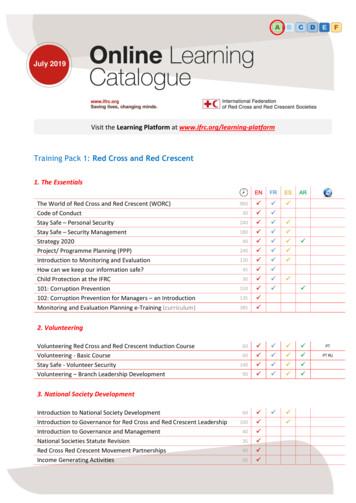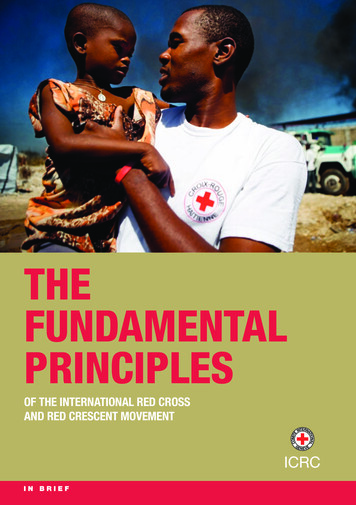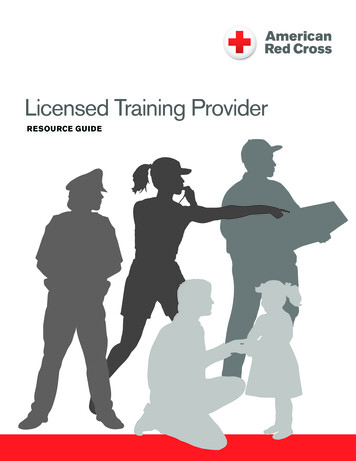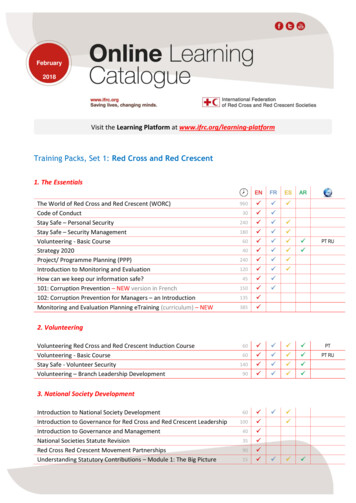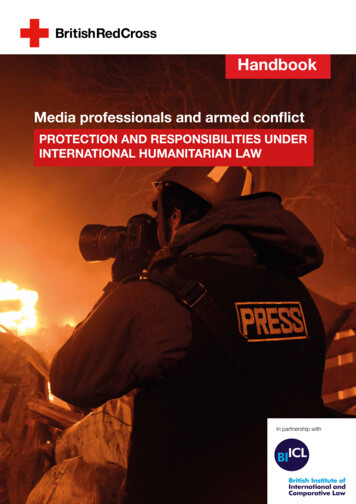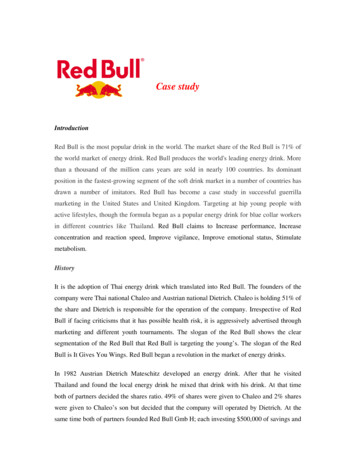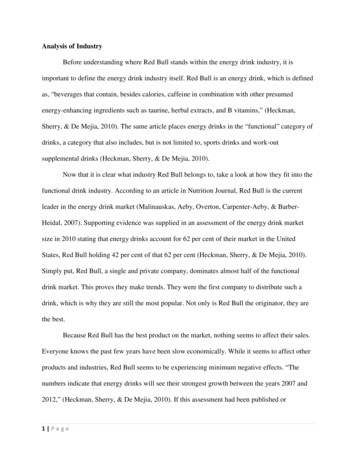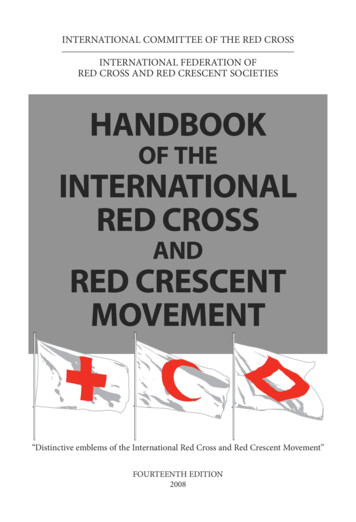
Transcription
INTERNATIONAL COMMITTEE OF THE RED CROSSINTERNATIONAL FEDERATION OFRED CROSS AND RED CRESCENT SOCIETIESHANDBOOKOF THEINTERNATIONALRED CROSSANDRED CRESCENTMOVEMENT“Distinctive emblems of the International Red Cross and Red Crescent Movement”FOURTEENTH EDITION2008
The Fundamental Principlesof the International Red Crossand Red Crescent MovementHumanity The International Red Cross and Red Crescent Movement, born of adesire to bring assistance without discrimination to the wounded on the battlefield,endeavours, in its international and national capacity, to prevent and alleviatehuman suffering wherever it may be found. Its purpose is to protect life and healthand to ensure respect for the human being. It promotes mutual understanding,friendship, cooperation and lasting peace amongst all peoples.Impartiality It makes no discrimination as to nationality, race, religious beliefs,class or political opinions. It endeavours to relieve the suffering of individuals, beingguided solely by their needs, and to give priority to the most urgent cases of distress.Neutrality In order to continue to enjoy the confidence of all, the Movement maynot take sides in hostilities or engage at any time in controversies of a political,racial, religious or ideological nature.Independence The Movement is independent. The National Societies, whileauxiliaries in the humanitarian services of their governments and subject to the lawsof their respective countries, must always maintain their autonomy so that they maybe able at all times to act in accordance with the principles of the Movement.Voluntary service It is a voluntary relief movement not prompted in any mannerby desire for gain.Unity There can be only one Red Cross or one Red Crescent Society in any onecountry. It must be open to all. It must carry on its humanitarian work throughoutits territory.Universality The International Red Cross and Red Crescent Movement, in whichall Societies have equal status and share equal responsibilities and duties in helpingeach other, is worldwide.The Fundamental Principles were proclaimed by the 20th International Conferenceof the Red Cross, Vienna, 1965. This is the revised text contained in the Statutesof the International Red Cross and Red Crescent Movement, adopted by the25th International Conference of the Red Cross, Geneva, 1986.
HANDBOOKOF THE INTERNATIONAL RED CROSSAND RED CRESCENT MOVEMENT
INTERNATIONAL COMMITTEE OF THE RED CROSSINTERNATIONAL FEDERATION OFRED CROSS AND RED CRESCENT SOCIETIESHandbookof the International Red Crossand Red Crescent MovementInternational humanitarian lawStatutes and RegulationsMain policies of the International Red Cross and Red Crescent MovementSelected Resolutions of the International Conferenceof the Red Cross and Red Crescent,the Council of Delegates and theGeneral Assembly of the FederationFOURTEENTH EDITIONGENEVA, 2008
This Handbook is published in English, French and Spanish. It can be obtainedfrom the following institutions:INTERNATIONAL COMMITTEE OF THE RED CROSS19, Avenue de la Paix1202 GENEVAwww.icrc.orgINTERNATIONAL FEDERATION OF RED CROSS ANDRED CRESCENT SOCIETIES17, Chemin des Crêts, Petit-Saconnex1211 GENEVA 19www.ifrc.orgThe texts reproduced here appear in their original form.No attempt has been made to eliminate stylistic discrepancies.ISBN: 978-2-940396-01-6 2008 International Committee of the Red Cross, GenevaInternational Federation of Red Crossand Red Crescent Societies, Geneva
TABLE OF CONTENTSForeword .17PART ONEINTERNATIONAL HUMANITARIAN LAWA. GENEVA CONVENTIONS AND ADDITIONAL PROTOCOLSI Geneva Convention for the Amelioration of the Conditionof the Wounded and Sick in Armed Forces in the Field,of 12 August 1949 .33II Geneva Convention for the Amelioration of the Condition ofWounded, Sick and Shipwrecked Members of Armed Forces at Sea,of 12 August 1949 .61III Geneva Convention relative to the Treatment of Prisoners of War,of 12 August 1949 .85IV Geneva Convention relative to the Protection of Civilian Persons inTime of War, of 12 August 1949 . 163V Protocol Additional to the Geneva Conventions of 12 August 1949,and relating to the Protection of Victims of International ArmedConflicts (Protocol I), of 8 June 1977. 233VI Protocol Additional to the Geneva Conventions of 12 August 1949,and relating to the Protection of Victims of Non-InternationalArmed Conflicts (Protocol II), of 8 June 1977. 311VII Protocol Additional to the Geneva Conventions of 12 August 1949,and relating to the Adoption of an Additional Distinctive Emblem(Protocol III), of 8 December 2005 . 323B. OTHER TEXTS OF INTERNATIONAL HUMANITARIAN LAWI Declaration of St. Petersburg of 1868 to the Effect of Prohibiting theUse of Certain Projectiles in Wartime. 331II Extract from the Declaration concerning the Prohibition of UsingBullets which Expand or Flatten Easily in the Human Body(International Peace Conference, The Hague, 1899) . 333
8TABLE OF CONTENTSIII Extract from The Hague Convention of 18 October 1907Respecting the Laws and Customs of War on Land(Convention No. IV) and Annexed Regulations. 334IV Extract from The Hague Convention of 18 October 1907Respecting the Rights and Duties of Neutral Powers andPersons in Case of War on Land (Convention No. V) . 346V Geneva Protocol of 17 June 1925 for the Prohibition of the Use inWar of Asphyxiating, Poisonous or other Gases and ofBacteriological Methods of Warfare. 348VI The Hague Convention of 14 May 1954 for the Protection ofCultural Property in the Event of Armed Conflict . 349VII Regulations for the Execution of The Hague Convention of14 May 1954 for the Protection of Cultural Property in theEvent of Armed Conflict. 364VIII Protocol to The Hague Convention of 14 May 1954 for theProtection of Cultural Property in the Event of Armed Conflict . 375IX Second Protocol to The Hague Convention of 14 May 1954 forthe Protection of Cultural Property in the Event of Armed Conflict 378X Convention of 10 April 1972 on the Prohibition of theDevelopment, Production and Stockpiling of Bacteriological(Biological) and Toxin Weapons and on their Destruction. 398XI Convention of 10 December 1976 on the Prohibition of Military orAny Other Hostile Use of Environmental Modification Techniques 403XII Convention on Prohibitions or Restrictions on the Use ofCertain Conventional Weapons Which May be Deemed tobe Excessively Injurious or to have Indiscriminate Effectsand annexed Protocols I-V. 408XIII Convention on the Prohibition of the Development, Production,Stockpiling and Use of Chemical Weapons and on theirDestruction (Extracts). 447XIV Convention on the Prohibition of the Use, Stockpiling, Productionand Transfer of Anti-Personnel Mines and on their Destruction . 454XV Rome Statute of the International Criminal Court (Extracts) . 468XVI Article 38 of the United Nations Convention of 20 November 1989on the Rights of the Child. 482XVII Optional Protocol to the Convention on the Rights of the Child onthe Involvement of Children in Armed Conflict. 483
TABLE OF CONTENTS9C. OTHER LEGAL TEXTSI Article 25 of the Covenant of the League of Nations (1920) . 489II Resolution 55 (I) of the United Nations General Assembly relativeto the Red Cross (1946) . 489III Resolution 2444/XXIII of the United Nations General Assemblyrelative to the Respect for Human Rights in Armed Conflict (1968) 490IV Final Declaration of the International Conference for the Protectionof War Victims (1993). 491V Observer Status for the International Committee of the Red Cross . 495VI Observer Status for the International Federation of Red Cross andRed Crescent Societies . 499VII Extract from the Rules of Procedure and Evidenceof the International Criminal Court. 504VIII Status of the Protocols Additional to the Geneva Conventions of1949 and relating to the protection of victims of armed conflicts . 506D. TABLE OF STATES PARTIES .510E. TABLE OF RECOGNIZED SIGNS .511
10TABLE OF CONTENTSPART TWOSTATUTES AND REGULATIONSDocument IRESOLUTIONS AND RECOMMENDATIONS OF THE GENEVAINTERNATIONAL CONFERENCE OF 1863 .515STATUTES OF THE INTERNATIONAL RED CROSS ANDRED CRESCENT MOVEMENT .517RULES OF PROCEDURE OF THE INTERNATIONAL RED CROSSAND RED CRESCENT MOVEMENT .535STATUTES OF THE INTERNATIONAL COMMITTEEOF THE RED CROSS .549CONSTITUTION OF THE INTERNATIONAL FEDERATIONOF RED CROSS AND RED CRESCENT SOCIETIES .557RULES OF PROCEDURE OF THE INTERNATIONAL FEDERATIONOF RED CROSS AND RED CRESCENT SOCIETIES .593Document VII SECTION I. AGREEMENT ON THE ORGANIZATION OF THEINTERNATIONAL ACTIVITIES OF THE COMPONENTS OF THEINTERNATIONAL RED CROSS AND RED CRESCENT MOVEMENT639SECTION II. SUPPLEMENTARY MEASURES TO ENHANCE THEIMPLEMENTATION OF THE SEVILLE AGREEMENT .655Document VIII RULES OF PROCEDURE OF THE STANDING COMMISSION OFTHE RED CROSS AND RED CRESCENT .665Document IIDocument IIIDocument IVDocument VDocument VIDocument IXREGULATIONS ON THE USE OF THE EMBLEM OF THE RED CROSSOR THE RED CRESCENT BY THE NATIONAL SOCIETIES .671Document XTHE PRINCIPLES AND RULES FOR RED CROSS AND REDCRESCENT DISASTER RELIEF .691SECTION I. REGULATIONS FOR THE HENRY DUNANT MEDAL.703SECTION II. CRITERIA FOR AWARDINGTHE HENRY DUNANT MEDAL .705Document XII REGULATIONS FOR THE RED CROSS AND RED CRESCENTPRIZE FOR PEACE AND HUMANITY .710Document XIII REGULATIONS FOR THE FLORENCE NIGHTINGALE MEDAL .711Document XIV REGULATIONS FOR THE EMPRESS SHÔKEN FUND .714Document XV REGULATIONS FOR THE FRENCH FUND MAURICE DE MADRE .717Document XI
TABLE OF CONTENTS11PART THREEMAIN POLICIES OF THE INTERNATIONAL RED CROSSAND RED CRESCENT MOVEMENTSECTION ITHE FUNDAMENTAL PRINCIPLESIPrinciples .II Application of the Principles.III Reaffirmation of the Fundamental Principles of the Red Cross.IV Observation of strict political neutrality by National Societies .V Proclamation of the Fundamental Principles of the Red Cross .VI Reading of Principles.SECTION IIPROMOTION OF NON-DISCRIMINATIONIElimination of racial discrimination.Plan of action against racism and racial discrimination .II Strengthening Humanitarian Values across Religious, Political andEthnic Lines, Resolution 12 of the 2001 Council of Delegates andAnnex.III Promote respect for diversity and fight discrimination and intolerance,Resolution 9 of the 2003 Council of Delegates and Annex, Mobilizationand action – The way forward.IV Promoting respect for diversity and non-discrimination, Resolution 3of the 2005 Council of Delegates and Annex,General criteria, orientations and guiding questions.721723724724725726727727732734737SECTION IIIORGANIZATION OF NATIONAL SOCIETIESAND THEIR RELATIONS WITH ACTORS OUTSIDE THE MOVEMENTCHAPTER IORGANIZATIONIModel Law on the recognition of the name of the Red Cross and RedCrescent Society.II Guidance for National Society statutes .III Characteristics of a well-functioning National Society .IV Strategy 2010: To improve the lives of vulnerable people by mobilizingthe power of humanity .V Policy on the Protection of Integrity of National Societies .746751792798824
12CHAPTER IITABLE OF CONTENTSRELATIONS BETWEEN NATIONAL SOCIETIESAND THEIR PUBLIC AUTHORITIESINational Red Cross and Red Crescent Societies as auxiliaries to thepublic authorities in the humanitarian field, Resolution 6 of the2003 Council of Delegates .II National Red Cross and Red Crescent Societies as auxiliaries to thepublic authorities in the humanitarian field, report to the 2003 Councilof Delegates.III National Societies as auxiliaries to the public authorities in thehumanitarian field, Resolution 9 of the 2005 Council of Delegates .IV Summary of the study on situations of armed conflict,Annex to the report to the 2005 Council of Delegates .V Specific nature of the International Red Cross and Red CrescentMovement in action and partnerships and the role of National Societiesas auxiliaries to the public authorities in the humanitarian field.CHAPTER III GUIDANCE ON RELATIONS WITH OTHER ACTORSOUTSIDE THE MOVEMENTIMinimum elements to be included in operational agreements betweenMovement components and their external operational partners.II Movement Policy for Corporate Sector Partnerships.III Guidance document on relations between the components of theMovement and military bodies .IV The Code of Conduct for the International Red Cross and Red CrescentMovement and non-governmental organizations (NGOs)in disaster relief.V Armed protection of humanitarian assistance .828829835837845848854864872879SECTION IVSTRATEGIES AND PLAN OF ACTIONStrategy for the International Red Cross and Red Crescent Movement,Resolution 6 of the 2005 Council of Delegates and Annex .II International Red Cross aid to refugees: statement of Policy .III Movement action in favour of refugees and internally displacedpersons, Resolution 4 of the 2001 Council of Delegates.IV Movement action in favour of refugees and internally displacedpersons and “Minimum Elements to be Included in OperationalAgreements between Movement Components and their OperationalPartners”, Resolution 10 of the 2003 Council of Delegates .V The Movement’s Policy on Advocacy,Resolution 6 of the 1999 Council of Delegates .VI Movement Strategy on Landmines,Resolution 10 of the 1999 Council of Delegates .I884906908911913915
TABLE OF CONTENTS13VII Explosive remnants of war and the Movement Strategy on Landmines,Resolution 11 of the 2003 Council of Delegates . 927VIII Plan of action concerning children in armed conflict. 929IX Restoring Family Links Stategy (and Implementation Plan)for the International Red Cross and Red Crescent Movement. 940
14TABLE OF CONTENTSPART FOURSELECTED RESOLUTIONS OF THE INTERNATIONAL CONFERENCEOF THE RED CROSS AND RED CRESCENT,THE COUNCIL OF DELEGATESAND THE GENERAL ASSEMBLY OF THE INTERNATIONAL FEDERATIONOF RED CROSS AND RED CRESCENT SOCIETIESSECTION IBASIS FOR AND PRINCIPLES OF THE INTERNATIONALRED CROSS AND RED CRESCENT MOVEMENTCHAPTER ICHAPTER IICHAPTER IIIUSE OF THE NAME AND EMBLEM OF THE RED CROSS, RED CRESCENTOR RED CRYSTAL . 979– Resolutions– Model law concerning the use and protection of the emblemsof the red cross, the red crescent and the red crystalTHE MOVEMENT’S MISSION. 999THE MOVEMENT, PROMOTIONOF NON-DISCRIMINATION AND PEACE .1000CHAPTER IVTHE MOVEMENT, WEAPONS AND DISARMAMENT . 1030CHAPTER VTHE MOVEMENT AND HUMAN RIGHTS . 1035CHAPTER VITHE MOVEMENT AND MAJOR CHALLENGES OF THE 21ST CENTURY . 1040SECTION IIINTERNATIONAL ORGANIZATION OF THE MOVEMENTCHAPTER IINTERNATIONAL CONFERENCEOF THE RED CROSS AND RED CRESCENT .1051CHAPTER IIINTERNATIONAL COMMITTEE OF THE RED CROSS . 1054CHAPTER IIIINTERNATIONAL FEDERATIONOF RED CROSS AND RED CRESCENT SOCIETIES .1055CHAPTER IVNATIONAL SOCIETIES . 1057CHAPTER VINTERNATIONAL RELATIONS . 1074CHAPTER VIFINANCING . 1076
TABLE OF CONTENTS15SECTION IIIINTERNATIONAL HUMANITARIAN LAW (IHL)CHAPTER IIMPLEMENTATION OF INTERNATIONAL HUMANITARIAN LAW . 1083CHAPTER IIADDITIONAL PROTOCOLS . 1112CHAPTER IIINATIONAL MEASURES TO IMPLEMENTINTERNATIONAL HUMANITARIAN LAW .1113CHAPTER IVDISSEMINATION OF INTERNATIONAL HUMANITARIAN LAW . 1119CHAPTER VDEVELOPMENT OF INTERNATIONAL HUMANITARIAN LAW . 1126SECTION IVACTIVITIES DURING ARMED CONFLICTSCHAPTER IPREPARATIONS FOR SITUATIONS OF ARMED CONFLICT . 1137CHAPTER IICOOPERATION AMONG NATIONAL SOCIETIES DURINGARMED CONFLICTS .1138CHAPTER IIINON-INTERNATIONAL ARMED CONFLICTS. 1139CHAPTER IVASSISTANCE AND PROTECTION FOR CONFLICT VICTIMS. 1142CHAPTER VCOMBATING HOSTAGE-TAKING, TORTURE,FORCED DISAPPEARANCE AND PIRACY .1201SECTION VRELIEF ACTIVITIES IN DISASTER SITUATIONSCHAPTER IRELIEF ORGANIZATION OF NATIONAL SOCIETIES . 1206CHAPTER IIINTERNATIONAL RELIEF ACTIONS. 1208CHAPTER IIIBENEFICIARIES OF RELIEF ACTIONS . 1235SECTION VIACTIVITIES IN PEACETIMECHAPTER IHEALTH . 1239CHAPTER IIBLOOD TRANSFUSION . 1244CHAPTER IIINURSING . 1248CHAPTER IVENVIRONMENT . 1249CHAPTER VYOUTH . 1250
16TABLE OF CONTENTSANNEXESANNEX ICHRONOLOGICAL LIST OF RESOLUTIONSREPRODUCED IN PARTS THREE AND FOUR .1259ANNEX IIINTERNATIONAL RED CROSS CONFERENCES . 1271ANNEX IIISESSIONS OF THE GENERAL COUNCIL, THE BOARD OF GOVERNORSAND THE GENERAL ASSEMBLY OF THE LEAGUE OF RED CROSSSOCIETIES, LATER INTERNATIONAL FEDERATION OF RED CROSSAND RED CRESCENT SOCIETIES . 1272ANNEX IVPRESIDENTS OF THE INTERNATIONAL COMMITTEE OF THE REDCROSS, CHAIRMEN AND PRESIDENTS OF THE LEAGUE, LATERINTERNATIONAL FEDERATION OF RED CROSS AND RED CRESCENTSOCIETIES AND CHAIRMEN OF THE STANDING COMMISSION OFTHE RED CROSS AND RED CRESCENT . 1274ANNEX VINTERNATIONAL RED CROSS AND RED CRESCENT MOVEMENTAND THE NOBEL PEACE PRIZE .1276ANNEX VILIST OF RECIPIENTS OF THE HENRY DUNANT MEDAL . 1277ANNEX VIILIST OF RECIPIENTS OF THE RED CROSS AND RED CRESCENTPRIZE FOR PEACE AND HUMANITY . 1281FLYLEAVESFrontThe Fundamental Principles of the International Red Cross and RedCrescent MovementBackFundamental rules of international humanitarian law applicable inarmed conflictsINSETS– Geneva Convention of 22 August 1864 for the Amelioration of theCondition of the Wounded in Armies in the Field– International Committee of the Red Cross– International Federation of Red Cross and Red Crescent Societies– National Red Cross and Red Crescent Societies– Statutory bodies of the International Red Cross and Red CrescentMovement– History of the International Red Cross and Red Crescent Movementand of international humanitarian law
FOREWORD17FOREWORDince 1889, when it was first published, the Handbook of the International RedCross and Red Crescent Movement has been intended both as a compilation ofthe principles and rules that have directed the activities of the Movement since itsfoundation and a practical guide for all those interested in the life of the Red Crossand Red Crescent.SIt therefore contains the international conventions and agreements that govern themission of the Movement’s components in time of conflict, the Statutes andRegulations connected with the organization and work of those institutions – theInternational Committee of the Red Cross, the International Federation of Red Crossand Red Crescent Societies, and the National Red Cross and Red Crescent Societies –and, finally, the main resolutions adopted by the Movement’s statutory bodies.Originally published by the International Committee of the Red Cross, theHandbook took the form of a twenty-two page pamphlet containing the substanceof the resolutions of the first International Conferences of the Red Cross.Increasing considerably in size with each successive issue, the Handbook was mostrecently reissued in 1951, 1953, 1971,1983 and 1994. From 1930, it became theInternational Red Cross Handbook, a joint publication of the InternationalCommittee of the Red Cross and the League of Red Cross Societies.1 Its layoutremained unchanged in later editions. The first part contained the GenevaConventions and several other international conventions with a bearing on RedCross and Red Crescent work; the second part was devoted to the Statutes andRegulations of the Movement’s international institutions; and the third part assembled the main resolutions of International Conferences, the Council of Delegatesand the Board of Governors of the League - now the General Assembly of theFederation. This layout has been maintained to a great extent in the current edition,however a fourth part with the main policies of the International Red Cross andRed Crescent Movement has been added.The ninth edition, in 1951, represented an important step in the development ofthis publication. It was at that time supplemented by the four Geneva Conventionsof 1949, to which the Additional Protocols of 1977 have now been appended. Since1971, on the other hand, the Handbook no longer gives the texts of theConventions prior to those of 1949, with the exception of the “mother” Conventionof 1864 which, in the present edition, will be found as an inset. A summary of thefundamental rules of international humanitarian law applicable in armed conflictshas been inserted at the end of the work, which makes for easier consultation.1 On 28 November 1991 the League changed its name to "International Federation of Red Cross and RedCrescent Societies".
18FOREWORDPart One which deals with international humanitarian law, gives the complete text ofthe Geneva Conventions of 1949, their 1977 Additional Protocols and the 2005Additional Protocol. Also included, as in the earlier editions, are other internationaltexts of general interest for the Movement and its work. These additions to theHandbook have been successively introduced. In point of fact, the 1977 AdditionalProtocols concern the law regulating the conduct of hostilities. The 2005 AdditionalProtocol (Protocol III) concerns the adoption of an additional distinctive emblem.This part also includes other texts of international law (previously listed under the lawof the Hague) Therefore, since the twelfth edition more space has been given to otherconventions and agreements of this type. The following will be found in this edition:the Declaration of St. Petersburg of 1868, covering the prohibition of certain explosiveprojectiles in time of war; the Declaration of The Hague of 1899 prohibiting the useof bullets which expand or flatten easily in the human body; the 1907 HagueConvention No. IV respecting the laws and customs of war on land; , the 1972Convention on the prohibition of the development, production and stockpiling ofbacteriological (biological) and toxin weapons and on their destruction; the 1976Convention on the prohibition of military or any other hostile use of environmentalmodification techniques; the Convention and Protocols of 1980 on prohibitions orrestrictions on the use of certain conventional weapons which may be deemed to beexcessively injurious or to have indiscriminate effects; subsequent Protocols to thisConvention such as the Protocol on blinding laser weapons and the Protocol onexplosive remnants of war ; extracts of the Rome Statute of the International CriminalCourt . Finally, this part contains a Resolution adopted by the United Nations GeneralAssembly in 1968, relating to respect for human rights in armed conflict and the FinalDeclaration of the International Conference for the protection of war victims.Two of the texts quoted in the Handbook are not part of international humanitarian law as such. The texts in question, an extract from the 1989 United NationsConvention on the rights of the child and the Optional Protocol to the Conventionon the rights of the child (25 May 2000) belong in fact to human rights law. Readersinterested in this branch of law should consult collections published by the international organizations directly concerned (one such publication is “Human rights Collection of international instruments”, published by the United Nations and regularly updated).Part Two of the Handbook, traditionally devoted to statutes, regulations and othernormative texts in force within the Movement, has been almost entirely revisedfrom the previous edition. Most of the changes are the result of amendments of theStatutes and Rules of Procedures of the Movement after the adoption of ProtocolIII additional to the Geneva Conventions in 2005, the revision by the governingbodies of the ICRC and the Federation of their institutions’ respective statutes andthe adoption in 1997 of the Agreement on the organization of the internationalactivities of the components of the International Red Cross and Red CrescentMovement (Seville Agreement) and in 2005 of the supplementary measures toenhance the implementation of the Seville Agreement.
19FOREWORDIn addition, the texts relating to the use of the emblem by the National Societies andto relief operations in disaster situations have been expanded, taking into accountrecent experience and the needs that have become apparent over the past decade.Part Three of this Handbook covers the main policies, strategies and plan of actionof the International Red Cross and Red Crescent Movement. This part contains normative texts such as those relative to the Fundamental Principles, to the promotionof non-discrimination, to the organization of National Societies and their relationswith actors outside the Movement. It also includes the Strategy for the InternationalRed Cross and Red Crescent Movement, updated in 2005. Texts on National Societiesas auxiliaries to the public authorities in the humanitarian field and others on theguidance of relations with other actors outside the Movement such as corporate sector partnerships and military bodies can be found here.Finally this part includes plans of action to strengthen humanitarian activities ofthe components of the Movement in specific areas such as the restoring family linksstrategy.As in previous editions, Part Four (formerly Part Three), contains a revised andupdated selection of the main resolutions of the
of the Red Cross, Vienna, 1965. This is the revised text contained in the Statutes of the International Red Cross and Red Crescent Movement, adopted by the 25th

